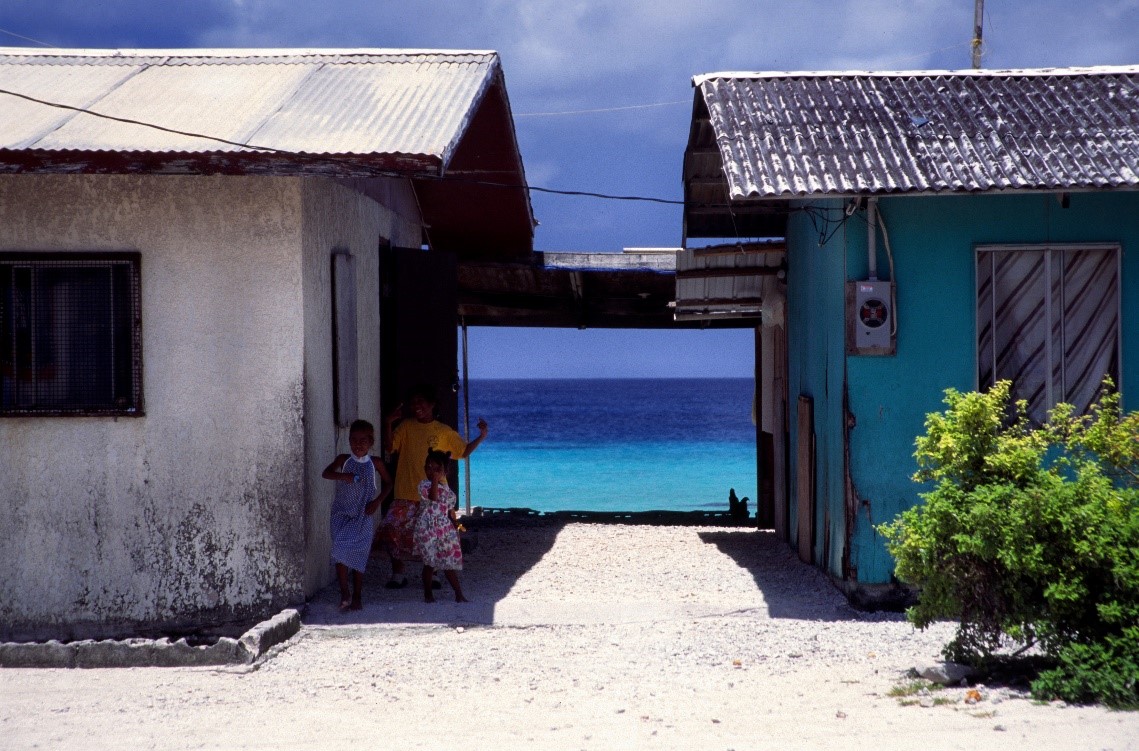What if you were told your home would permanently disappear in the near future. How would you react?
The citizens of the Republic of the Marshall Islands are currently dealing with this dilemma.

Their country consists of over 1200 islands and two chains of coral atolls. With an average elevation of 6.5 ft above sea level, the Marshall Islands are highly susceptible to the effects of climate change: sea-level rise, drought, and extreme weather events.
As a result, Marshallese communities no longer have the ability to produce traditional crops such as taro and arrowroot or maintain their fishing industry. Majuro and Ebeye, the two most populous atolls, now rely heavily on imported food.
Currently, the country is concentrating on adapting to the effects of climate change. Critical aspects of the nation’s climate adaptation efforts are focused on constructing seawalls, developing a renewable energy plan, and meeting its nationally determined contributions.
Even with this adaptation plan in place, though, the Marshallese know that they won’t be able to prevent the disappearance of their home.
From the Islands to the Ozarks
In response, many Marshallese are migrating to the U.S.—and specifically to a small community in Arkansas. But why Arkansas?
After World War II the United States took control of the Marshall Islands from Japan, ultimately using the island atolls as a nuclear weapons testing site. In 1986, the Marshall Islands gained independence from the U.S. and entered into the Compact of Free Association (COFA). This agreement allows citizens of compact nations—the Federated States of Micronesia, the Republic of Palau, and the Republic of the Marshall Islands—to travel and work in the U.S without a visa.

With the option of free entry, many Marshallese are migrating to the U.S. and, because of the journey of one man, to Springdale, Arkansas. After the enactment of COFA, John Moody, a Marshallese citizen, moved to Springdale, getting a job with a Tyson’s chicken processing plant. Over time, Moody helped his friends and family move to Arkansas and acquire jobs within the poultry industry and they, in turn, helped others relocate.
Today, 15,000 Marshallese make up a thriving climate refugee community in Springdale. They’ve launched 30 churches, a radio station, convenience stores, and, a consulate of the Republic of the Marshall Islands. To help with the transition of Marshallese migrants to Arkansas and develop a relationship with the non-Marshallese community, Melisa Laelan cofounded the Arkansas Coalition of Marshallese (ACOM).
When there is a misunderstanding between the Marshallese community and the Arkansas community, the ACOM steps in to help both groups understand each other’s cultures. The ACOM was instrumental in the creation of a traditional Marshallese Kokor carved at the Shiloh Museum of Ozark History in Arkansas.
For a glimpse inside this vibrant community, watch the Springdale Arkansas Christmas Program performed by the Namdrik Jebta Group:
The future of the Marshallese and other climate refugees
The Marshallese are not the only community being forced from their homes. Populations in Bangladesh, Mali, Chad, Niger, and Guatemala are also under threat as climate change intensifies. Like the Marshall Islands, these countries are facing the detrimental effects of climate change, including droughts, floods, and rising temperatures. As a result, their populations are migrating inland or north into other countries.
However, unlike these other climate refugees, migrants from water-locked areas (like Kiribati, Tuvalu, and the Maldives) do not have the option of traveling north into another country. Citizens of island nations are facing the reality that their countries will be completely submerged underwater. The Springdale Marshallese community acknowledges that their future is in the United States, but their hearts break for their home and the memories it holds.
An international agreement such as COFA provides an opportunity to relocate for climate refugees who will be forced to relocate due to climate change and to those whose homes will ultimately succumb to sea-level rise.
In 2023, COFA will be up for renewal, and it is unclear what results will come from renegotiations. There is an increasing need for international agreements that address the issue of climate-induced migration.
How you can help
After learning about this global issue, you may be wondering, “What next?”
To support the Marshallese in the fight against climate change visit https://jojikum.org/. This site is home to Jo-Jikum, a Marshall Islands-based nonprofit dedicated to empowering Marshallese youth to become change-makers and contribute to the survival of their home. Through youth-empowerment and climate activism, Jo-Jikum hopes to inform the world of the climate dilemma occurring in the Marshall Islands as well as highlight the amazing work the country is doing to address environmental issues.
Follow Jo-Jikum on Facebook and share new developments from the organization to bring awareness to the effects of climate change in the Marshall Islands.


Very insightful. I wasn’t aware of the large number of Marshallese migrants to the U.S.! It’s promising to see that they are taking infrastructure measures to adapt to climate change, but developing and maintaining a diverse set of climate response strategies, like migration under COFA, seems critical. Hopefully, we can all make sure COFA is renewed!